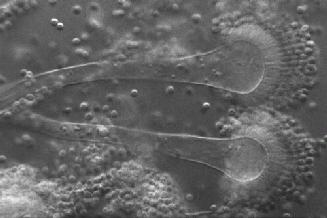Scientists have cracked the genetic code of a fungus responsible for deadly infections and allergic reactions.

Scientists have cracked the genetic code of a fungus responsible for deadly infections and allergic reactions.
Researchers at the Institute for Genomic Research in the UK hope their work will lead to better diagnostic tests and more effective treatments against infections of the fungus Aspergillus fumigatus, which causes more infections than any other mold fungus and is especially dangerous for people with weakened immune systems. The cooperation of the researchers is reported in the prestigious journal "Nature". The researchers discovered that the genome of the fungus includes eight chromosomes, carrying a total of 10,000 genes! They found 700 genes that were unique or significantly different from the genes of the less toxic mushroom - Nauserturba fischeri. In addition, the researchers identified for the first time nine allergy-causing substances produced by the fungus.
Experts believe that Aspergillus fumigatus has become an increasing threat in recent years, as more and more people with weakened immune systems survive. These include patients who have had transplants and people with leukemia or AIDS. The fungus also triggers asthma attacks in people with particularly sensitive immune systems. The fungus causes allergic diseases among asthmatic patients and among patients suffering from cystic fibrosis.
The fungus has extraordinary properties - it can thrive in a very wide range of temperatures - from 70 degrees Celsius (the temperature in a compost pile) to 37 degrees Celsius - the temperature of the human body.
Now the researchers are looking for these unique genes to gather clues that will explain why Aspergillus fumigatus is so contagious and causes infections.
It is likely that the key genes that code for the high infectivity of the fungus have a complex role in controlling many aspects of the way the fungal cells break down and build different substances. The researchers' plan is to systematically "knock out" various genes and thus test their influence and individual function. The mutation carrying a silenced gene (therefore there is no production of the substances to which the silenced gene is encoded) can be compared to the wild strain of the fungus and thus locate the substances and the mechanisms for which the silenced gene is responsible.
Lead researcher Dr. William Nirman says: "This genomic sequence will be central to the development of tools for the effective treatment of Aspergillus fumigatus infections, which are becoming more and more common among the aging population."
Dr. Paul Dyer, a mushroom expert at the University of Nottingham in the UK says: "There is still a lot of work to be done and the days are still early. However, this research begins for the first time to point out the reasons why such closely related species of mushrooms are so different in their effects and degree of toxicity to humans."
Dr. Dyer says that Aspergillus fumigatus is very common in nature. It is estimated that each person breathes about 200 spores (spores) of the fungus a day. Hence, most of the population is exposed to the fungus, but the fungal infection is usually caused by those with a weakened immune system.
The researchers also determined the genetic sequence of two additional species of Aspergillus fungi, including Aspergillus oryzae, which has been used in the production process of foods such as soybean paste and soy sauce for about two thousand years.
The Sanger Institute and its colleagues are conducting a preliminary analysis of the genome of Aspergillus fumigatus. This research involves the preparation of a library of bacterial artificial chromosomes (BAC) of Aspergillus fumigatus, to "take the fingerprints" (locate and identify) of 3000 BAC tribes and thus create a physical map and then determine a sequence of 10 physically related tribes to that It is estimated that the genome size of Aspergillus fumigatus is 30-35Mb.
Although Aspergillus fumigatus is very important from a medical point of view, very little is known about its genetic composition. So far, the full sequence of less than 60 genes of the fungus has been determined. An extensive genomic analysis was performed in the model fungus Neurospora crassa and Aspergillus nidolens. It is hoped that comparative studies of the genome of Aspergillus with the genome of the model fungus will clarify the genetic basis of pathogenicity.
For news at the BBC
For information on the website of the Sanger Institute in Great Britain
